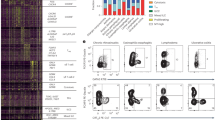Abstract
Chronic myeloproliferative neoplasms (MPNs) are a group of related conditions characterized by the overproduction of cells from one or more myeloid lineages. More than 95% of cases of polycythemia vera, and roughly half of essential thrombocythemia and primary myelofibrosis acquire a unique somatic 1849G>T JAK2 mutation (encoding V617F) that is believed to be a critical driver of excess proliferation1,2,3,4. We report here that JAK2V617F-associated disease is strongly associated with a specific constitutional JAK2 haplotype, designated 46/1, in all three disease entities compared to healthy controls (polycythemia vera, n = 192, P = 2.9 × 10−16; essential thrombocythemia, n = 78, P = 8.2 × 10−9 and myelofibrosis, n = 41, P = 8.0 × 10−5). Furthermore, JAK2V617F specifically arises on the 46/1 allele in most cases. The 46/1 JAK2 haplotype thus predisposes to the development of JAK2V617F-associated MPNs (OR = 3.7; 95% CI = 3.1–4.3) and provides a model whereby a constitutional genetic factor is associated with an increased risk of acquiring a specific somatic mutation.
This is a preview of subscription content, access via your institution
Access options
Subscribe to this journal
Receive 12 print issues and online access
$209.00 per year
only $17.42 per issue
Buy this article
- Purchase on Springer Link
- Instant access to full article PDF
Prices may be subject to local taxes which are calculated during checkout




Similar content being viewed by others
References
James, C. et al. A unique clonal JAK2 mutation leading to constitutive signalling causes polycythaemia vera. Nature 434, 1144–1148 (2005).
Kralovics, R. et al. A gain-of-function mutation of JAK2 in myeloproliferative disorders. N. Engl. J. Med. 352, 1779–1790 (2005).
Levine, R.L. et al. Activating mutation in the tyrosine kinase JAK2 in polycythemia vera, essential thrombocythemia, and myeloid metaplasia with myelofibrosis. Cancer Cell 7, 387–397 (2005).
Baxter, E.J. et al. Acquired mutation of the tyrosine kinase JAK2 in human myeloproliferative disorders. Lancet 365, 1054–1061 (2005).
Kralovics, R., Guan, Y. & Prchal, J.T. Acquired uniparental disomy of chromosome 9p is a frequent stem cell defect in polycythemia vera. Exp. Hematol. 30, 229–236 (2002).
Jones, A.V. et al. Widespread occurrence of the JAK2 V617F mutation in chronic myeloproliferative disorders. Blood 106, 2162–2168 (2005).
Pikman, Y. et al. MPLW515L is a novel somatic activating mutation in myelofibrosis with myeloid metaplasia. PLoS Med. 3, e270 (2006).
Kralovics, R. Genetic complexity of myeloproliferative neoplasms. Leukemia 22, 1841–1848 (2008).
Rumi, E. et al. Disease anticipation in familial myeloproliferative neoplasms. Blood 112, 2587–2588 (2008).
Landgren, O. et al. Increased risks of polycythemia vera, essential thrombocythemia, and myelofibrosis among 24, 577 first-degree relatives of 11, 039 patients with myeloproliferative neoplasms in Sweden. Blood 112, 2199–2204 (2008).
Pardanani, A., Fridley, B.L., Lasho, T.L., Gilliland, D.G. & Tefferi, A. Host genetic variation contributes to phenotypic diversity in myeloproliferative disorders. Blood 111, 2785–2789 (2008).
Wellcome Trust Case Control Consortium. Genome-wide association study of 14,000 cases of seven common diseases and 3,000 shared controls. Nature 447, 661–678 (2007).
Stephens, M. & Donnelly, P. A comparison of bayesian methods for haplotype reconstruction from population genotype data. Am. J. Hum. Genet. 73, 1162–1169 (2003).
Cario, H., Goerttler, P.S., Steimle, C., Levine, R.L. & Pahl, H.L. The JAK2V617F mutation is acquired secondary to the predisposing alteration in familial polycythaemia vera. Br. J. Haematol. 130, 800–801 (2005).
Barrett, J.C. et al. Genome-wide association defines more than 30 distinct susceptibility loci for Crohn's disease. Nat. Genet. 40, 955–962 (2008).
Sandberg, E.M., Wallace, T.A., Godeny, M.D., VonDerLinden, D. & Sayeski, P.P. Jak2 tyrosine kinase: a true jak of all trades? Cell Biochem. Biophys. 41, 207–232 (2004).
Khoury, M.J., Beaty, T.H. & Cohen, B.H. Fundamentals of Genetic Epidemiology (Oxford University Press, New York, 1993).
Easton, D.F. et al. Genome-wide association study identifies novel breast cancer susceptibility loci. Nature 447, 1087–1093 (2007).
Eeles, R.A. et al. Multiple newly identified loci associated with prostate cancer susceptibility. Nat. Genet. 40, 316–321 (2008).
Di Bernardo, M.C. et al. A genome-wide association study identifies six susceptibility loci for chronic lymphocytic leukemia. Nat. Genet. 40, 1204–1210 (2008).
Jones, A.V. et al. Minimal molecular response in polycythemia vera patients treated with imatinib or interferon alpha. Blood 107, 3339–3341 (2006).
Acknowledgements
This study was supported by Leukaemia Research (UK) Specialist Programme Grant 0280 and makes use (in part) of data generated by the WTCCC. A full list of the investigators who contributed to the generation of the WTCCC data are available from www.wtccc.org.uk, funding for which was provided by the Wellcome Trust under award 076113. We are grateful to P. Strike (Salisbury Research and Development Support Unit) for statistical advice. A.R. was supported by the Deutsche José Carreras Leukämie-Stiftung e.V. - DJCLS R06/02, Germany.
Author information
Authors and Affiliations
Contributions
The study was designed by A.V.J., A. Chase., F.G. and N.C.P.C. A.V.J. performed the laboratory analysis. R.T.S., D.O., K.Z., Y.L.W., H.L.P., H.C. and A.R. provided clinical samples and associated information. A.V.J., A. Chase, A. Collins and N.C.P.C. analyzed the data. N.C.P.C. wrote the first draft of the manuscript and all authors contributed to and approved the final version.
Corresponding author
Supplementary information
Supplementary Text and Figures
Supplementary Figure 1 and Supplementary Table 1 (PDF 45 kb)
Rights and permissions
About this article
Cite this article
Jones, A., Chase, A., Silver, R. et al. JAK2 haplotype is a major risk factor for the development of myeloproliferative neoplasms. Nat Genet 41, 446–449 (2009). https://doi.org/10.1038/ng.334
Received:
Accepted:
Published:
Issue Date:
DOI: https://doi.org/10.1038/ng.334
This article is cited by
-
Inherited polygenic effects on common hematological traits influence clonal selection on JAK2V617F and the development of myeloproliferative neoplasms
Nature Genetics (2024)
-
JAK2V617F variant allele frequency, non-driver mutations, single-nucleotide variants and polycythemia vera outcome
Journal of Cancer Research and Clinical Oncology (2023)
-
CHST15 gene germline mutation is associated with the development of familial myeloproliferative neoplasms and higher transformation risk
Cell Death & Disease (2022)
-
Pathogenese und molekulare Diagnostik der akuten myeloischen Leukämie
Die Onkologie (2022)
-
Essential thrombocythaemia progression to the fibrotic phase is associated with a decrease in JAK2 and PDL1 levels
Annals of Hematology (2022)



